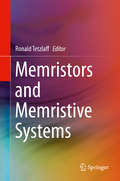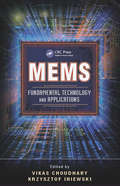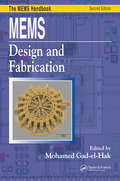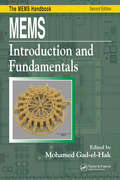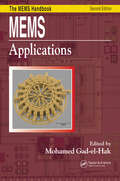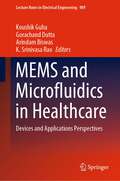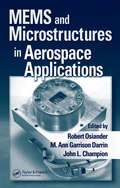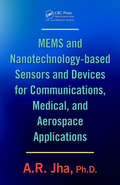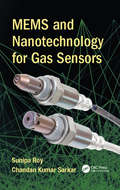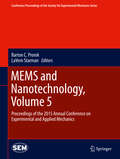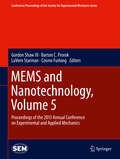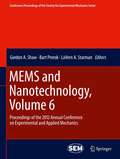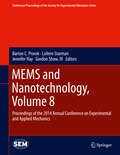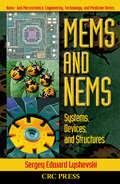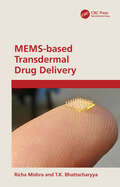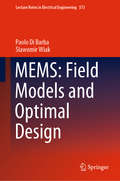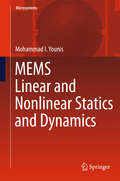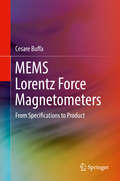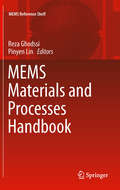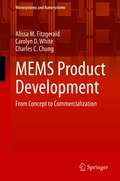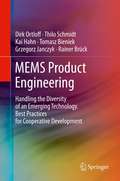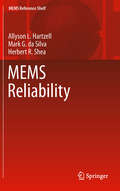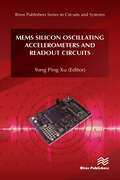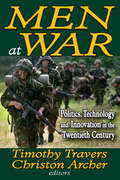- Table View
- List View
Memristors and Memristive Systems
by Ronald TetzlaffThis book provides a comprehensive overview of current research on memristors, memcapacitors and, meminductors. In addition to an historical overview of the research in this area, coverage includes the theory behind memristive circuits, as well as memcapacitance, and meminductance. Details are shown for recent applications of memristors for resistive random access memories, neuromorphic systems and hybrid CMOS/memristor circuits. Methods for the simulation of memristors are demonstrated and an introduction to neuromorphic modeling is provided.
MEMS: Fundamental Technology and Applications (Devices, Circuits, and Systems #15)
by Krzysztof Iniewski Vikas ChoudharyThe microelectromechanical systems (MEMS) industry has experienced explosive growth over the last decade. Applications range from accelerometers and gyroscopes used in automotive safety to high-precision on-chip integrated oscillators for reference generation and mobile phones. MEMS: Fundamental Technology and Applications brings together groundbreaking research in MEMS technology and explores an eclectic set of novel applications enabled by the technology. The book features contributions by top experts from industry and academia from around the world. The contributors explain the theoretical background and supply practical insights on applying the technology. From the historical evolution of nano micro systems to recent trends, they delve into topics including: Thin-film integrated passives as an alternative to discrete passives The possibility of piezoelectric MEMS Solutions for MEMS gyroscopes Advanced interconnect technologies Ambient energy harvesting Bulk acoustic wave resonators Ultrasonic receiver arrays using MEMS sensors Optical MEMS-based spectrometers The integration of MEMS resonators with conventional circuitry A wearable inertial and magnetic MEMS sensor assembly to estimate rigid body movement patterns Wireless microactuators to enable implantable MEMS devices for drug delivery MEMS technologies for tactile sensing and actuation in robotics MEMS-based micro hot-plate devices Inertial measurement units with integrated wireless circuitry to enable convenient, continuous monitoring Sensors using passive acousto-electric devices in wired and wireless systems Throughout, the contributors identify challenges and pose questions that need to be resolved, paving the way for new applications. Offering a wide view of the MEMS landscape, this is an invaluable resource for anyone working to develop and commercialize MEMS applications.
MEMS: Design and Fabrication
by Mohamed Gad-el-HakThoroughly revised and updated, the new edition of the best-selling MEMS Handbook is now presented as a three-volume set that offers state-of-the-art coverage of microelectromechanical systems. Through chapters contributed by top experts and pioneers in the field, MEMS: Design and Fabrication presents a comprehensive look at the materials, procedures, tools, and techniques of MEMS fabrication. New chapters in this edition examine the materials and fabrication of polymer microsystems and optical diagnostics for investigating the entrance length in microchannels. Rigorous yet accessible, this volume provides the practical knowledge needed for work in cutting-edge MEMS applications.
MEMS: Introduction and Fundamentals (Mechanical and Aerospace Engineering Series)
by Mohamed Gad-el-HakThoroughly revised and updated, the new edition of the best-selling MEMS Handbook is now presented as a three-volume set that offers state-of-the-art coverage of microelectromechanical systems. The first volume, MEMS: Introduction and Fundamentals builds the required background and explores various physical considerations of MEMS. Topics include scaling, simulation models, the basics of control theory, and the physics of materials flow, thin liquid films, and bubble/drop transport. New chapters in this edition address lattice Boltzmann simulations and microscale hydrodynamics. Standing well on its own, this books builds an outstanding foundation for further exploration of MEMS and their applications.
MEMS: Applications
by Mohamed Gad-el-HakAs our knowledge of microelectromechanical systems (MEMS) continues to grow, so does The MEMS Handbook. The field has changed so much that this Second Edition is now available in three volumes. Individually, each volume provides focused, authoritative treatment of specific areas of interest. Together, they comprise the most comprehensive collection
MEMS and Microfluidics in Healthcare: Devices and Applications Perspectives (Lecture Notes in Electrical Engineering #989)
by Koushik Guha Gorachand Dutta Arindam Biswas K. Srinivasa RaoThe book introduces the research significance of biomedical instrumentation and discusses micro-fabrication techniques utilized for biomedical devices. This book primarily focuses on the reader enlightenment on MEMS medical devices by introducing all the diagnostic devices and treatment tools at one place. The book covers in-depth technical works and general introductions to the devices such that the book can reach technical as well as non-technical readers.
MEMS and Microstructures in Aerospace Applications
by Robert Osiander M. Ann Garrison Darrin John L. ChampionThe promise of MEMS for aerospace applications has been germinating for years, and current advances bring the field to the very cusp of fruition. Reliability is chief among the challenges limiting the deployment of MEMS technologies in space, as the requirement of zero failure during the mission is quite stringent for this burgeoning field. MEMS and Microstructures in Aerospace Applications provides all the necessary tools to overcome these obstacles and take MEMS from the lab bench to beyond the exosphere.The book begins with an overview of MEMS development and provides several demonstrations of past and current examples of MEMS in space. From this platform, the discussion builds to fabrication technologies; the effect of space environmental factors on MEMS devices; and micro technologies for space systems, instrumentation, communications, thermal control, guidance navigation and control, and propulsion. Subsequent chapters explore factors common to all of the described systems, such as MEMS packaging, handling and contamination control, material selection for specific applications, reliability practices for design and application, and assurance practices.Edited and contributed by an outstanding team of leading experts from industry, academia, and national laboratories, MEMS and Microstructures in Aerospace Applications illuminates the path toward qualifying and integrating MEMS devices and instruments into future space missions and developing innovative satellite systems.
MEMS and Nanotechnology-Based Sensors and Devices for Communications, Medical and Aerospace Applications
by A. R. JhaThe integration of microelectromechanical systems (MEMS) and nanotechnology (NT) in sensors and devices significantly reduces their weight, size, power consumption, and production costs. These sensors and devices can then play greater roles in defense operations, wireless communication, the diagnosis and treatment of disease, and many more applicat
MEMS and Nanotechnology for Gas Sensors
by Chandan Kumar Sarkar Sunipa RoyHow Can We Lower the Power Consumption of Gas Sensors? <P><P>There is a growing demand for low-power, high-density gas sensor arrays that can overcome problems relative to high power consumption. Low power consumption is a prerequisite for any type of sensor system to operate at optimum efficiency. Focused on fabrication-friendly microelectromechanical systems (MEMS) and other areas of sensor technology, MEMS and Nanotechnology for Gas Sensors explores the distinct advantages of using MEMS in low power consumption, and provides extensive coverage of the MEMS/nanotechnology platform for gas sensor applications. This book outlines the microfabrication technology needed to fabricate a gas sensor on a MEMS platform. It discusses semiconductors, graphene, nanocrystalline ZnO-based microfabricated sensors, and nanostructures for volatile organic compounds. It also includes performance parameters for the state of the art of sensors, and the applications of MEMS and nanotechnology in different areas relevant to the sensor domain. <P><P>In addition, the book includes: <li>An introduction to MEMS for MEMS materials, and a historical background of MEMS <li>A concept for cleanroom technology <li>The substrate materials used for MEMS <li>Two types of deposition techniques, including chemical vapour deposition (CVD) <li>The properties and types of photoresists, and the photolithographic processes <li>Different micromachining techniques for the gas sensor platform, and bulk and surface micromachining <li>The design issues of a microheater for MEMS-based sensors <li>The synthesis technique of a nanocrystalline metal oxide layer <li>A detailed review about graphene; its different deposition techniques; and its important electronic, electrical, and mechanical properties with its application as a gas sensor <li>Low-cost, low-temperature synthesis techniques <li>An explanation of volatile organic compound (VOC) detection and how relative humidity affects the sensing parameters <P><P>MEMS and Nanotechnology for Gas Sensors provides a broad overview of current, emerging, and possible future MEMS applications. MEMS technology can be applied in the automotive, consumer, industrial, and biotechnology domains.
MEMS and Nanotechnology, Volume 5
by Barton C. Prorok Lavern StarmanThe 16thInternational Symposium on MEMS and Nanotechnology, Volume 5 of the Proceedings of the 2015SEM Annual Conference& Exposition on Experimental and Applied Mechanics, the fifth volume of nine from the Conference, brings together contributions to this important area of research and engineering. The collection presents early findings and case studies on a wide range of areas, including: Microscale and Microstructural Effects on Mechanical Behavior Dynamic Micro/Nanomechanics In-situ Techniques Mechanics of Graphene Indentation and Small Scale Testing MEMS
MEMS and Nanotechnology, Volume 5
by Gordon Shaw III Barton C. Prorok Lavern Starman Cosme FurlongMEMS and Nanotechnology, Volume 5: Proceedings of the 2013 Annual Conference on Experimental and Applied Mechanics, the fifth volume of eight from the Conference, brings together contributions to this important area of research and engineering The collection presents early findings and case studies on a wide range of areas, including: Microelectronics Packaging Single Atom/Molecule Mechanical Testing MEMS Devices & Fabrication In-Situ Mechanical Testing Nanoindentation Experimental Analysis of Low-Dimensional Materials for Nanotechnology
MEMS and Nanotechnology, Volume 6
by Lavern A. Starman Gordon A. Shaw Barton C. ProrokMEMS and Nanotechnology, Volume 6: Proceedings of the 2012 Annual Conference on Experimental and Applied Mechanics represents one of seven volumes of technical papers presented at the Society for Experimental Mechanics SEM 12th International Congress & Exposition on Experimental and Applied Mechanics, held at Costa Mesa, California, June 11-14, 2012. The full set of proceedings also includes volumes on Dynamic Behavior of Materials, Challenges in Mechanics of Time-Dependent Materials and Processes in Conventional and Multifunctional Materials, Imaging Methods for Novel Materials and Challenging Applications, Experimental and Applied Mechanics, Mechanics of Biological Systems and Materials and, Composite Materials and Joining Technologies for Composites.
MEMS and Nanotechnology, Volume 8
by Barton C. Prorok Lavern Starman Jennifer Hay Gordon Shaw IIIMEMS and Nanotechnology, Volume 8: Proceedings of the 2014 Annual Conference on Experimental and Applied Mechanics, the eighth volume of eight from the Conference, brings together contributions to this important area of research and engineering The collection presents early findings and case studies on a wide range of areas, including: Small-Scale Plasticity MEMS and Electronic Packaging Mechanics of Graphene Interfacial Mechanics Methods in Measuring Small-Scale Displacements Organic and Inorganic Nanowires AFM and Resonant-Based Methods Thin Films and Nano fibers
MEMS and NEMS: Systems, Devices, and Structures (Nano- and Microscience, Engineering, Technology and Medicine)
by Sergey Edward LyshevskiThe development of micro- and nano-mechanical systems (MEMS and NEMS) foreshadows momentous changes not only in the technological world, but in virtually every aspect of human life. The future of the field is bright with opportunities, but also riddled with challenges, ranging from further theoretical development through advances in fabrication technologies, to developing high-performance nano- and microscale systems, devices, and structures, including transducers, switches, logic gates, actuators and sensors. MEMS and NEMS: Systems, Devices, and Structures is designed to help you meet those challenges and solve fundamental, experimental, and applied problems. Written from a multi-disciplinary perspective, this book forms the basis for the synthesis, modeling, analysis, simulation, control, prototyping, and fabrication of MEMS and NEMS. The author brings together the various paradigms, methods, and technologies associated with MEMS and NEMS to show how to synthesize, analyze, design, and fabricate them. Focusing on the basics, he illustrates the development of NEMS and MEMS architectures, physical representations, structural synthesis, and optimization. The applications of MEMS and NEMS in areas such as biotechnology, medicine, avionics, transportation, and defense are virtually limitless. This book helps prepare you to take advantage of their inherent opportunities and effectively solve problems related to their configurations, systems integration, and control.
MEMS-based Transdermal Drug Delivery
by Richa Mishra T.K. BhattacharyyaThis book introduces transdermal drug delivery and the developments that have taken place in various transdermal drug delivery techniques including the system-level design approach of a novel miniaturized medical device to offer precise and painless drug delivery via a skin-based transdermal route. It discusses the microelectromechanical systems (MEMS)-based fabrication technique and the design, fabrication and characterization of different MEMS-based components like microneedles and micropumps. It further includes a MEMS-based component micropump with design, analysis, fabrication and characterization of the transdermal drug delivery device and challenges encountered in the design improvements.Features: Summarizes transdermal drug delivery systems especially with a focus on MEMS and microneedles, including theoretical concepts Emphasizes system integration by describing simulation and design techniques as well as experimental fabrication Discusses system-level integration for miniaturized therapeutic devices Includes working simulation models covering microneedles and micropump analysis Explores future direction in development of pertinent devices The book is aimed at researchers, professionals, and graduate students in biomedical engineering, microelectronics, micro-electro-mechanical-systems, and drug delivery.
MEMS: Field Models and Optimal Design (Lecture Notes in Electrical Engineering #573)
by Paolo Di Barba Slawomir WiakThis book highlights numerical models as powerful tools for the optimal design of Micro-Electro-Mechanical Systems (MEMS). Most MEMS experts have a background in electronics, where circuit models or behavioral models (i.e. lumped-parameter models) of devices are preferred to field models. This is certainly convenient in terms of preliminary design, e.g. in the prototyping stage. However, design optimization should also take into account fine-sizing effects on device behavior and therefore be based on distributed-parameter models, such as finite-element models. The book shows how the combination of automated optimal design and field-based models can produce powerful design toolboxes for MEMS. It especially focuses on illustrating theoretical concepts with practical examples, fostering comprehension through a problem-solving approach. By comparing the results obtained using different methods, readers will learn to identify their respective strengths and weaknesses. In addition, special emphasis is given to evolutionary computing and nature-inspired optimization strategies, the effectiveness of which has already been amply demonstrated. Given its scope, the book provides PhD students, researchers and professionals in the area of computer-aided analysis with a comprehensive, yet concise and practice-oriented guide to MEMS design and optimization. To benefit most from the book, readers should have a basic grasp of electromagnetism, vector analysis and numerical methods.
MEMS Linear and Nonlinear Statics and Dynamics
by Mohammad I. YounisMEMS Linear and Nonlinear Statics and Dynamics presents the necessary analytical and computational tools for MEMS designers to model and simulate most known MEMS devices, structures, and phenomena. This book also provides an in-depth analysis and treatment of the most common static and dynamic phenomena in MEMS that are encountered by engineers. Coverage also includes nonlinear modeling approaches to modeling various MEMS phenomena of a nonlinear nature, such as those due to electrostatic forces, squeeze-film damping, and large deflection of structures. The book also: Includes examples of numerous MEMS devices and structures that require static or dynamic modelingProvides code for programs in Matlab, Mathematica, and ANSYS for simulating the behavior of MEMS structuresProvides real world problems related to the dynamics of MEMS such as dynamics of electrostatically actuated devices, stiction and adhesion of microbeams due to electrostatic and capillary forcesMEMS Linear and Nonlinear Statics and Dynamics is an ideal volume for researchers and engineers working in MEMS design and fabrication.
MEMS Lorentz Force Magnetometers
by Cesare BuffaThis book deals with compasses for consumer applications realized in MEMS technology, to support location-based and orientation-based services in addition to 'traditional' functionalities based on navigation. Navigation is becoming a must-have feature in portable devices and the presence of a compass also makes location-based augmented reality emerge, where a street map or a camera image could be overlaid with highly detailed information about what is in front of the user. To make these features possible both industries and scientific research focus on three axis magnetometers. The author describes a full path from specifications (driven by customers' needs/desires) to prototype and preparing the way to industrialization and commercialization. The presentation includes an overview of all the major steps of this research and development process, highlighting critical points and potential pitfalls, as well as how to forecast or mitigate them. Coverage includes system design, specifications fulfillment, design strategy and project development methodology, in addition to traditional topics such as microelectronics design, sensor design, development of an experimental setup and characterization. The author uses a practical approach, including pragmatic guidelines and design choices, while maintaining focus on the final target, prototyping in the direction of industrialization and mass production.
MEMS Materials and Processes Handbook
by Reza Ghodssi Pinyen LinMEMs Materials and Processes Handbook" is a comprehensive reference for researchers searching for new materials, properties of known materials, or specific processes available for MEMS fabrication. The content is separated into distinct sections on "Materials" and "Processes". The extensive Material Selection Guide" and a "Material Database" guides the reader through the selection of appropriate materials for the required task at hand. The "Processes" section of the book is organized as a catalog of various microfabrication processes, each with a brief introduction to the technology, as well as examples of common uses in MEMs.
MEMS Product Development: From Concept to Commercialization (Microsystems and Nanosystems)
by Alissa M. Fitzgerald Carolyn D. White Charles C. ChungDrawing on their experiences in successfully executing hundreds of MEMS development projects, the authors present the first practical guide to navigating the technical and business challenges of MEMS product development, from the initial concept stage all the way to commercialization. The strategies and tactics presented, when practiced diligently, can shorten development timelines, help avoid common pitfalls, and improve the odds of success, especially when resources are limited. MEMS Product Development illuminates what it really takes to develop a novel MEMS product so that innovators, designers, entrepreneurs, product managers, investors, and executives may properly prepare their companies to succeed.
MEMS Product Engineering
by Dirk Ortloff Thilo Schmidt Kai Hahn Tomasz Bieniek Grzegorz Janczyk Rainer BrückThis book provides the methodological background to directing cooperative product engineering projects in a micro and nanotechnology setting. The methodology is based on well-established methods like PRINCE2 and StageGate, which are supplemented by best practices that can be individually tailored to the actual nature and size of the project at hand. This book is intended for everyone who takes an active role in either practical product engineering or in teaching it. This includes project and product management staff and program management offices in companies working on innovation projects, those active in innovation, as well as professors and students in engineering and management.
MEMS Reliability
by Allyson L. Hartzell Mark G. da Silva Herbert R. SheaThe successful launch of viable MEMs product hinges on MEMS reliability, the reliability and qualification for MEMs based products is not widely understood. Companies that have a deep understanding of MEMs reliability view the information as a competitive advantage and are reluctant to share it. MEMs Reliability, focuses on the reliability and manufacturability of MEMS at a fundamental level by addressing process development and characterization, material property characterization, failure mechanisms and physics of failure (POF), design strategies for improving yield, design for reliability (DFR), packaging and testing.
MEMS Silicon Oscillating Accelerometers and Readout Circuits
by Yong Ping XuMost MEMS accelerometers on the market today are capacitive accelerometers that are based on the displacement sensing mechanism. This book is intended to cover recent developments of MEMS silicon oscillating accelerometers (SOA), also referred to as MEMS resonant accelerometer. As contrast to the capacitive accelerometer, the MEMS SOA is based on the force sensing mechanism, where the input acceleration is converted to a frequency output. MEMS Silicon Oscillating Accelerometers and Readout Circuits consists of six chapters and covers both MEMS sensor and readout circuit, and provides an in-depth coverage on the design and modelling of the MEMS SOA with several recently reported prototypes. The book is not only useful to researchers and engineers who are familiar with the topic, but also appeals to those who have general interests in MEMS inertial sensors. The book includes extensive references that provide further information on this topic.
Men Against Fire: The Problem of Battle Command in Future War
by S. L. A. MarshallThis book examines why only one in four men in battle seem to fire their guns, and offers means by which the number of active soldiers can be increased.
Men at War: Politics, Technology, and Innovation in the Twentieth Century
by Christon ArcherThe growing number of books on military history and the lively interest in military history courses at colleges and universities show that the study of war is enjoying considerable popularity. The reasons for this are arguable, but of immediate interest is the kind of military history that is taught and written. Here the student of war comes across an interesting division of opinion as to how military history should be written. Military history, lying as it does on the frontier between history and military science, requires knowledge of both fields. This fact often presents a difficulty to the history teacher.Generally speaking, history is a discipline by virtue of its subject matter, not by virtue of a particular methodology such as is characteristic of the sciences and of some social sciences. The perspective of Men at War is a cross between a professional internalist approach and a civilian contextual view. This separation is not unique to military history, for the same dualism tends to occur in those areas of history, such as law and medicine, that can be written both by members of the profession concerned lawyers and doctors and by those outside the profession.The problem is that at one extreme the contextual view can take the emotional content out of war, while at the other extreme the internalist view can put too much in. Men at War seeks to locate a military history that combines the professional, internalist method and the civilian, contextual method by showing that these are two fundamental sources from which a war derives. Seen in this way, this volume breaks new ground in defining the sources of twentieth-century power.
